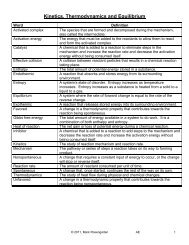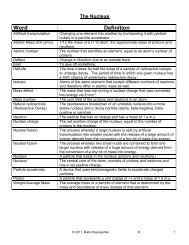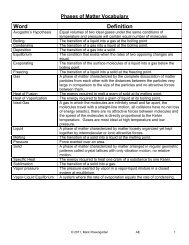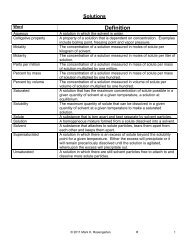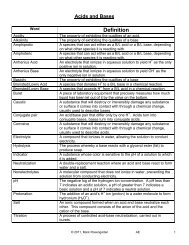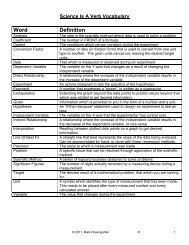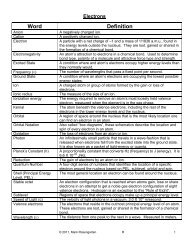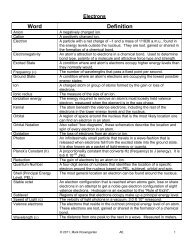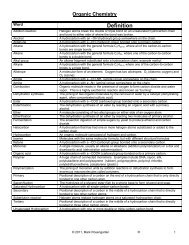Unit 4 - Mark Rosengarten
Unit 4 - Mark Rosengarten
Unit 4 - Mark Rosengarten
You also want an ePaper? Increase the reach of your titles
YUMPU automatically turns print PDFs into web optimized ePapers that Google loves.
1) Atomic Structure (The Nucleus) (HW: p. 19, 20)<br />
Essential Question: What is everything made up of?<br />
Atoms are the smallest pieces an element can be broken into and still retain the properties of that element. It comes<br />
from the Greek word atomos, meaning “indivisible” (unbreakable).<br />
Atoms are so tiny that they can not be seen directly. They can be detected through X-ray crystallography or atomic<br />
force microscopes, but only indirectly.<br />
It takes 602 000 000 000 000 000 000 000 atoms of hydrogen to weigh 1 gram (the mass of a small paper clip).<br />
Atoms are made up of the following particles:<br />
A) Nucleons (Particles in the Nucleus)<br />
1) Protons: have a mass of 1 atomic mass unit (1.66 X 10 -24 grams) and a charge of +1. They are found in the<br />
nucleus of the atom, and the number of protons in the atom is the atomic number, which identifies what element the<br />
atom is. Oxygen (O) has an atomic number of 8, which means there are 8 protons in the nucleus. Since protons are<br />
the only particle in the nucleus to have a charge, the charge of the nucleus is + (# of protons). Since oxygen has 8<br />
protons in the nucleus, oxygen has a nuclear charge of +8. We will use nuclear charge down the road for the<br />
purposes of explaining why it is easier to do nuclear fusion with smaller nuclei and why atoms have the sizes they do.<br />
2) Neutrons: have a mass of 1 atomic mass unit, and no charge. They are found in the nucleus of the atom, and the<br />
number of neutrons added to the number of protons gives you the mass number of the atom. The number of neutrons<br />
does not affect the identity of the element. Oxygen’s most common form has a mass number of 16. Since there are 8<br />
protons in the nucleus of oxygen, this means there must also be 8 neutrons to give a combined mass of 16. The<br />
number of protons and neutrons does NOT have to be equal. In addition, atoms of any given element can have<br />
differing numbers of neutrons. Atoms of the same element with different numbers of neutrons in their nuclei are called<br />
ISOTOPES of one another. The most common isotope is the one who’s mass equals the average atomic mass given<br />
on the periodic table rounded to the nearest whole number. Since O has a given average mass of 15.9994, the most<br />
common isotope of O is O-16, or Oxygen with a mass number of 16. See the diagram below.<br />
B) Particles Outside The Nucleus<br />
3) Electrons: have a mass of 1/1836 amu (9.11×10 −28 grams) and a charge of -1. They are found orbiting the nucleus<br />
in energy levels. Atoms gain, lose or share electrons when they form chemical bonds. If electrons are gained and<br />
lost, an ionic bond is formed. If electrons are shared, a covalent bond is formed. The number of electrons in the atom<br />
equals the number of protons. Atoms are neutrally charged, so the + charged protons and the – charged electrons<br />
must be equal in number to give a neutral charge. Oxygen has 8 protons in its nucleus, so there must be 8 electrons<br />
zipping around outside the nucleus in energy levels. In this unit, the only thing you need to worry about is how to find<br />
out how many electrons an atom has, and what the charge and mass of an electron are. Later in the course, you will<br />
see just how important electrons are to all of chemistry. They are the part of the atom responsible for all chemical<br />
bonding. If it weren’t for electrons, there would be no compounds. H would not bond to O, and water would not exist!<br />
© 2011, <strong>Mark</strong> <strong>Rosengarten</strong> AE 2



